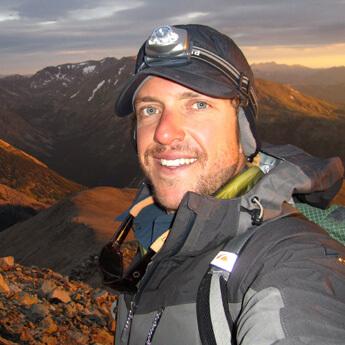The State of Ultra Running 2020
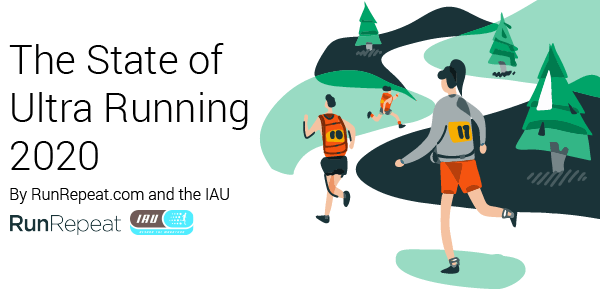
NEW: The State of US Marathons 2025
In this study, we explore the trends in ultra running over the last 23 years. We have analyzed 5,010,730 results from 15,451 ultra running events, making this the largest study ever done on the sport.
Key results
- Female ultra runners are faster than male ultra runners at distances over 195 miles. The longer the distance the shorter the gender pace gap. In 5Ks men run 17.9% faster than women, at marathon distance the difference is just 11.1%, 100-mile races see the difference shrink to just .25%, and above 195 miles, women are actually 0.6% faster than men.
- Participation has increased by 1676% in the last 23 years from 34,401 to 611,098 yearly participations and 345% in the last 10 years from 137,234 to 611,098. There have never been more ultra runners.
- More ultra runners are competing in multiple events per year. In 1996, only 14% of runners participated in multiple races a year, now 41% of participants run more than one event per year. There is also a significant increase in the % of people who run 2 races a year, 17.2% (from 7.7% to 24.9%) and 3 races, 6.7% (from 2.8% to 9.5%).
- There have never been more women in ultrarunning. 23% of participants are female, compared to just 14% 23 years ago.
- Ultra runners have never been slower across distance, gender and age group. The average pace in 1996 was 11:35 min/mile, currently, it is 13:16 min/mile. The average runner has added 1:41 min/mile to their average pace, which is a slowdown of 15% since 1996. We don't believe that individual runners have become slower, but that these distances are attracting less prepared runners now because the sport is more mainstream.
- Runners improve their pace in their first 20 races, and then their pace stabilizes. From their first to their second race runners improve by 0:17 min/mile (2%) on average. But by their 20th they improve by 1:45 min/mile (12.3%).
- The fastest ultra running nations are South Africa (average pace 10:36 min/mile), Sweden (11:56 min/mile), and Germany (12:01 min/mile).
- A record amount of people travel abroad for ultra running events. 10.3% of people travel abroad to run an ultra, for 5Ks this percentage is just 0.2%.
- Runners in the longer distances have a better pace than the runners in the shorter distances for each age group.
- All age groups have a similar pace, around 14:40 min/mile. Which is unusual compared to the past and to other distances.
- The average age of ultra runners has decreased by 1 year in the last 10 years. It has changed from 43.3 years to 42.3 years.
- Ultra runners are getting more engaged - the average number of ultras per year has increased from 1.3 to 1.7 over the last 23 years.
About the researchers
The study is a product of collaboration between Paul Ronto and Vania Nikolova. Ronto is an avid runner with 6 marathons under his belt and RunRepeat's Content Director. Nikolova holds a Ph.D. in Mathematical Analysis.
Data and methodology
- The data covers over 85% of ultra running events worldwide.
- The analysis includes any distance runs longer than 26.2 miles including trail runs, mountain runs, and road runs.
- The analysis includes runs set for any time over 6 hours since a small portion of ultra races do not have a singular set distance.
- In over 5,010,730 finish times only 3.77% of participants, race in a timed race compared to a set distance race.
- The study was done in collaboration with the International Association of Ultrarunners (IAU).
- The data includes the results of 5,010,730 million finishers from over 15 thousand races.
- This study looks at data from 1996-2018
Participation
Participation in ultra running events is on the rise. There has been a 1676% increase in participation since 1996. There were just 34,401 ultra running participations back in 96 and now they are 611,098.
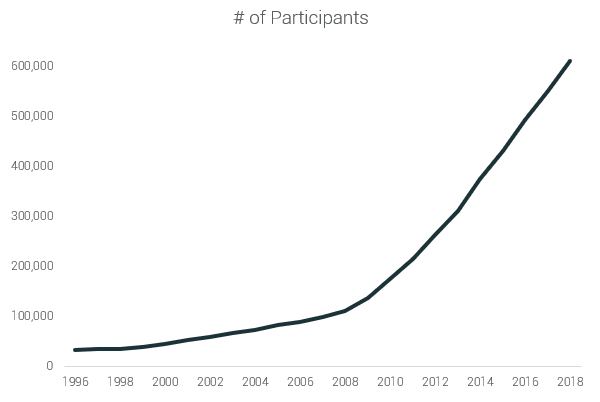
This is interesting because after 2015 we see a decline in participation in 5Ks, and there is a leveling off in the participation in marathons. This suggests that the most dedicated runners are looking for bigger and bigger challenges as running becomes more and more popular and marathon running is considered more mainstream than extreme.
When we take 2001 as a benchmark we see that the growth rate of ultrarunning participation surpasses that of marathons since 2009 and that of 5Ks since 2015.

The participation trends for the shorter races (<50 miles) and the longer races (>50 miles) both show a significant increase in participation.
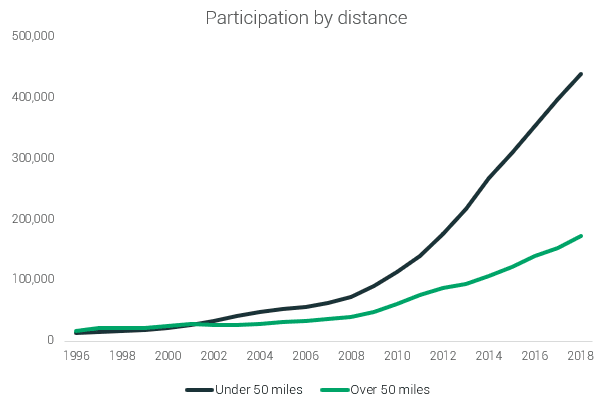
Participation in the races under 50 miles has increased 33 times, and in the races over 50 miles - 9.3 times.
23 years ago, the majority of ultra runners were competing in races over 50 miles long. Now, only one-quarter prefer the most challenging distances.

Out of the top 20 nations France, the USA, and South Africa have the highest proportions of the world's ultra runners.
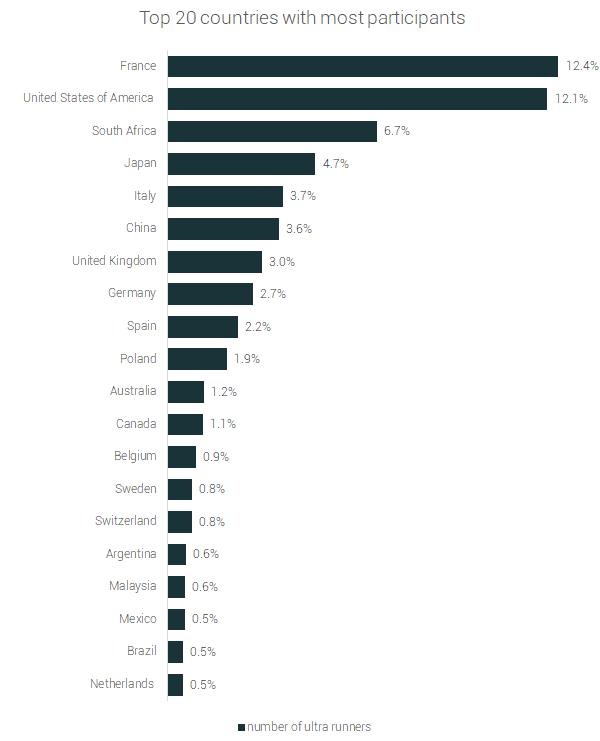
When we take the number of runners from the country compared to its population we see that the picture changes quite drastically - France is still number 1, but the next ones are Japan and China. Here, the United States is in 10th place, and South Africa on 11th.

The information shown until now is based on the number of participations per year, and not on the number of unique participants. Of course, there are a lot of ultra runners who run more than one race per year. We've made this analysis, and it shows that the number of unique participants in 1996 was 24,102 and now it is 329,584 - a growth of 1,267%.
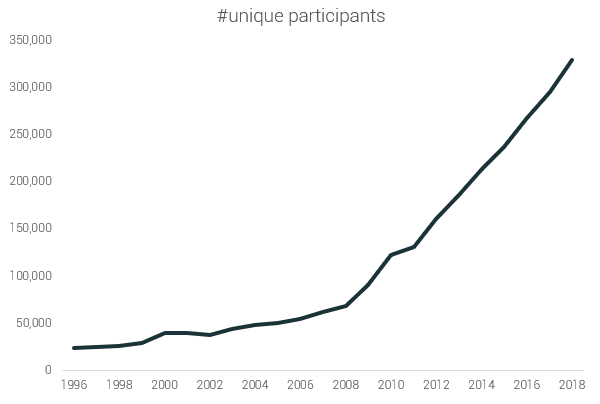
The distribution of participants based on the number of races they run every year is shown here.
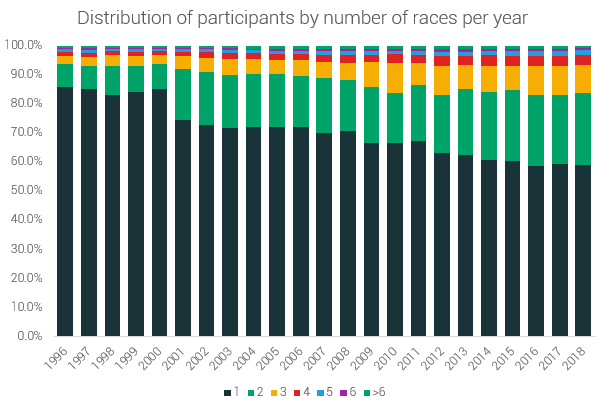
Still, the majority of participants run one ultra per year, but there is a definite rise in the average number of runs per year - from 1.3 per year to 1.7 races per year.
In 1996, only 14% of runners participated in multiple races a year, now 41% of participants run more than one event per year. There is also a significant increase in the % of people who run 2 races a year, 17.2% (from 7.7% to 24.9%) and 3 races, 6.7% (from 2.8% to 9.5%).
Gender distribution of participants
As we expect, the longer the distance the smaller % of female participants - there is a 45% difference in female participation in 5Ks and the longest races.

Even though the % of women in ultrarunning is still small, it has actually never been higher. Over the last 23 years, the % of female participants relative to men has increased by 64% (a nominal increase of 9%).

There are quite big national differences. We see that in Australia, Canada, and the US the % of female ultra runners is much higher than the world's average (23%) for female participation in marathons. It's interesting that the countries with the smallest % of female ultra runners are European, which have strong traditions in running.
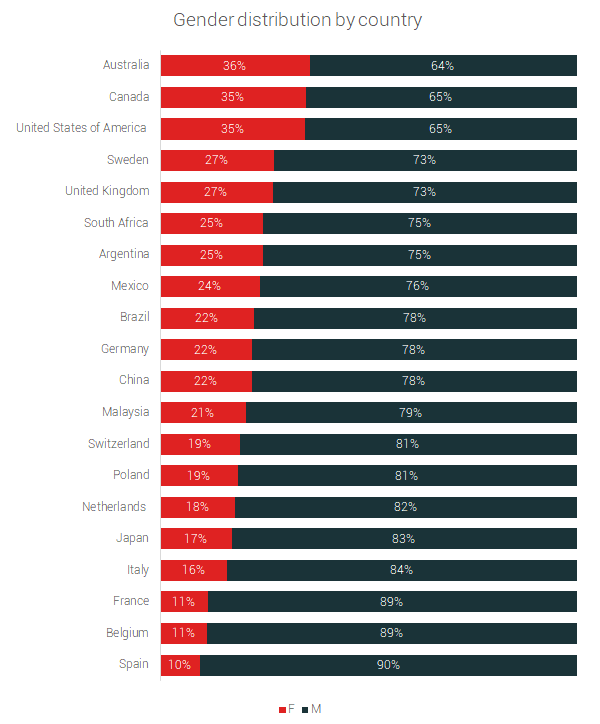
Average pace
As with all the other distances, which we have discussed in our State of running article, ultra runners are also getting slower.
Because ultrarunning includes all distances longer than a marathon, there is a huge variety of different races. For this reason, we'll be comparing average paces. In general, the average pace of ultra runners has increased from 11:35 min/mile to 13:16 min/mile (15%).

Pace differences by distance
It is surprising to see, that the average pace of the ultra runners in the shorter distances is quite slower than the average pace of the runners in the longer distances. But it makes sense because the longer distances are attracting the most devoted runners.
The pace of the runners in the distances under 50 miles has changed from 16:02 to 16:47 min/mile (a slowdown of 5 %). For the runners in the distances over 50 miles, the change is from 11:31 to 13:09 min/mile (a slowdown of 14%).
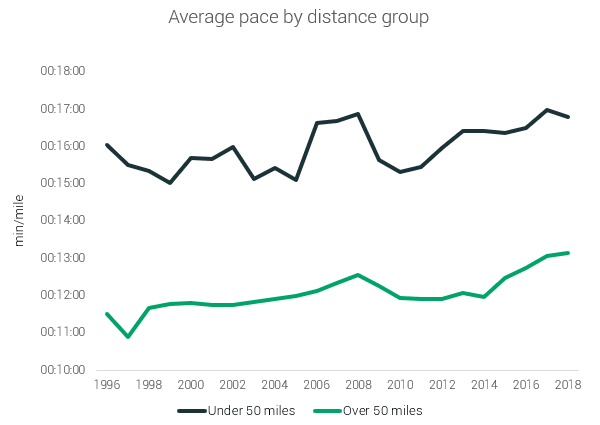
Gender differences in pace
The average paces of both genders are quite close now. The female pace has changed from 12:25 to 13:23 min/mile - a slow down of 58 seconds (8%). The male pace has changed from 11:24 to 13:21 min/mile - a slow down of 1 minute 57 seconds (17%).

What becomes evident is that the longer the distance the smaller the difference. In the 100K races, the difference is 0.5% and in the 100-mile races, women are just a quarter of a percent slower than men. The phenomenon that women are better at pacing than men is examined at more length here.
And what is truly amazing is that women become faster than men at the most extreme distances over 195 miles long.

Pace differences by country
The best ultra runners are from South Africa with an average pace of 10:36 min/mile. The runner-ups are Sweden (11:56 min/mile) and Germany (12:01 min/mile).
The slowest ultra running nations are Argentina (15:20 min/mile), Mexico (15:30 min/mile) and Malaysia (15:55 min/mile).

All these countries have slowed down over the last 10 years. The countries that have slowed down most are among the slowest in the rankings.
Argentina has slowed down most - by 5:08 min/mile, next are Mexico (5:04 min/mile) and Poland (4:10 min/mile). The least slowed down countries are China (by 3 seconds/mile), South Africa (by 30 seconds/mile), and the US (by 59 seconds/mile).
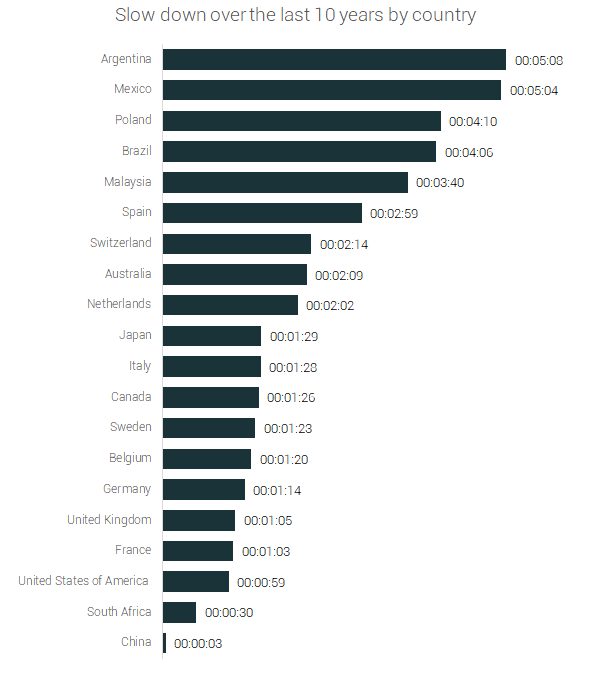
Country rankings by gender
Female rankings
The fastest women are from South Africa with an average pace of 11:11 min/mile. Second is Sweden (12:27 min/mile) and Germany (12:33 min/mile).
The slowest women are from Malaysia (16:00 min/mile), Argentina (16:19 min/mile) and Mexico (16:40 min/mile).
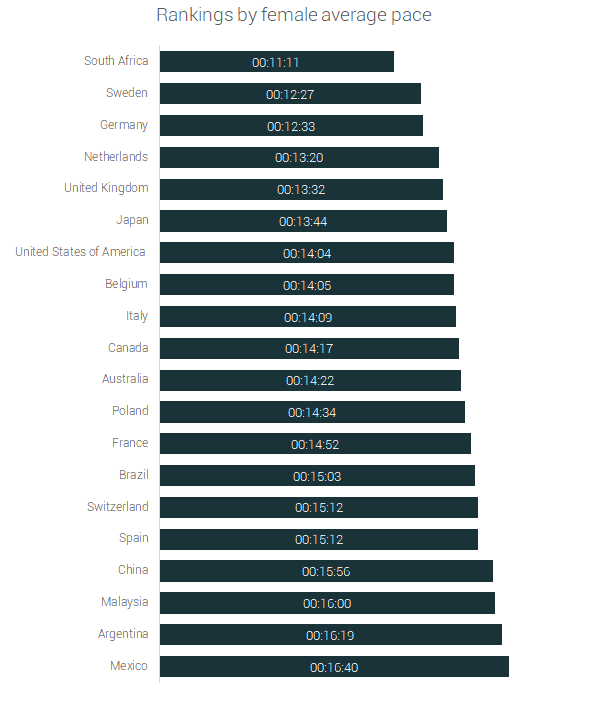
Male rankings
The fastest men are also from South Africa (10:23 min/mile), Sweden (11:43 min/mile) and Germany (11:53 min/mile).
The slowest men are from Argentina (15:01 min/mile), Mexico (15:06 min/mile) and Malaysia (15:54 min/mile).
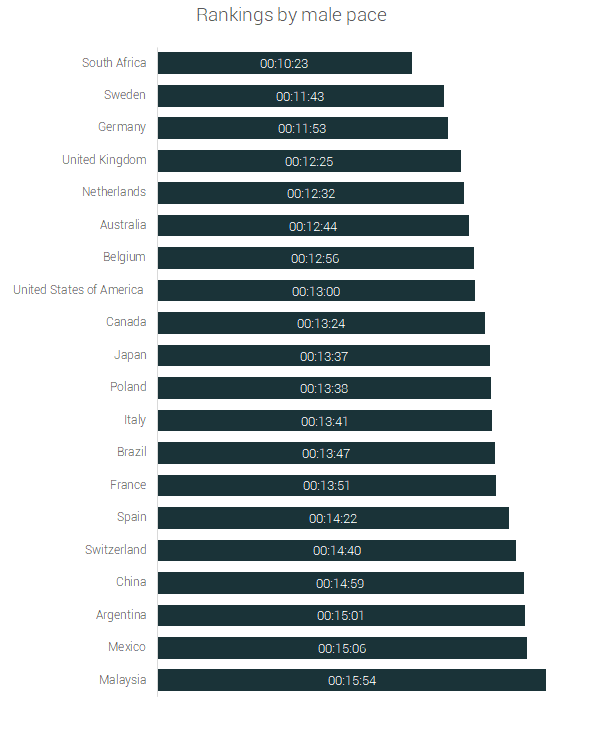
The women from South Africa are faster than the men from all other countries, apart from South Africa. The women from Sweden are faster than all men, apart from the top 4.
Women from Germany are faster than men from 15 countries.
Even the fifth slowest women - the ones from Spain - are faster than the slowest men the ones from Malaysia.
Age
From the State of running, we know that the runners in the standard distances have never been older.

But in ultrarunning, the average age of the participants has gone down by 1 year in the last 10 years. It has changed from 43.3 to 42.3 years.
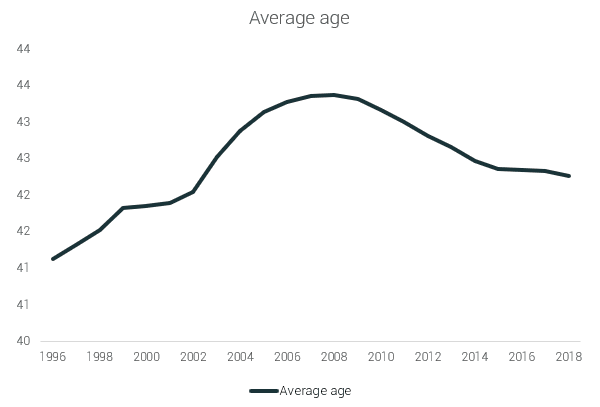
Women are on average 1.3 years younger than the men in ultra running. Also, the average age of ultra runners is stably going down over the last 10 years. The average age of female ultra runners has decreased by 1.2 years over the last 10 years and the average age of male runners - by 1.1 years.
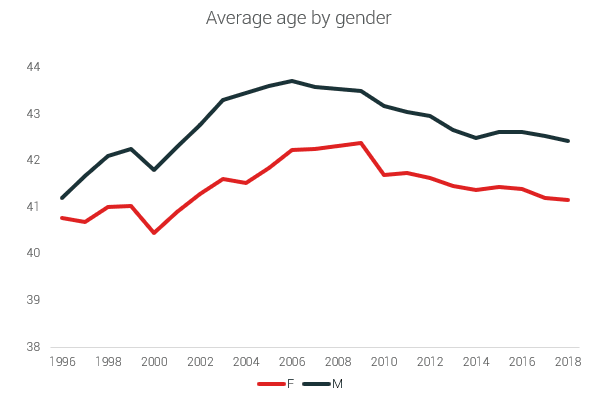
Usually, the longer the distance, the older the participants. As we see from the chart below, this holds true with 1 exception - 5Ks. This is due to the fact that as the least challenging 5Ks attract runners of all ages, and dedicated runners continue competing in their 60s, 70s and even older.

The age distribution of ultra runners has stayed quite stable. The most noticeable change is in the decrease in the participants under 30 and the increase in the proportion of participants in their 50s.
Around 70% of all runners are in their 30s and 40s.
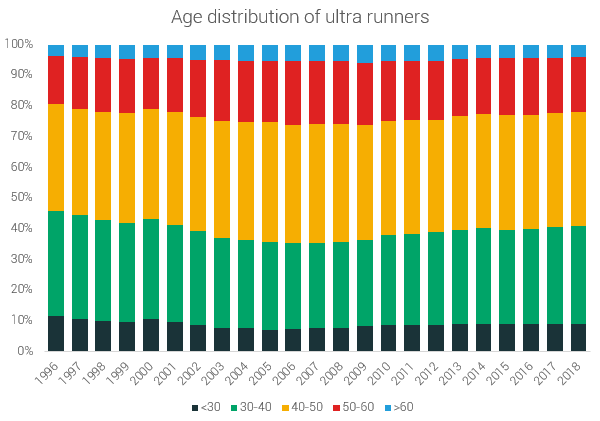
Age and pace
All age groups have slowed down, and now, the average pace of all age groups is almost equal. This is a huge surprise and we don't see such a convergence at any other distance.

The youngest participants have changed their pace from 10:44 to14:42 min/mile - a slowdown of 3:58 min/mile (37%). The participants in their 30s have changed their pace from 10:40 to 14:38 min/mile - an increase of 3:58 min/mile (37%). The youngest participants have slowed down most.
The participants in their 40s have changed their pace from 11:09 to 14:14 min/mile - a slowdown of 3:33 min/mile (32%). The participants in their 50s have changed their pace from 11:51 to 14:42 min/mile - an increase of 2:50 min/mile (24%). And the oldest participants have changed their pace from 12:53 to 14:55 min/mile - a slowdown of 2:01 min/mile (16%).
The longer the ultra distance is, the better the pace of female runners.

This is also true for male runners.
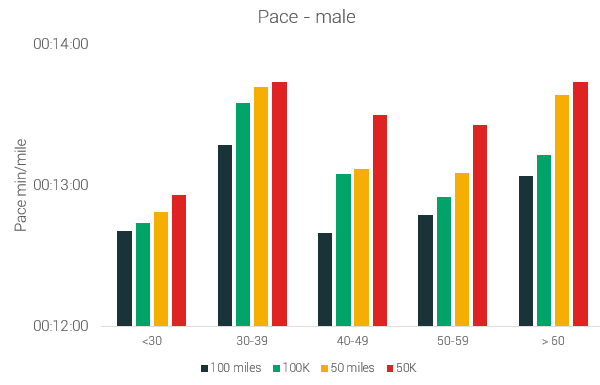
Both these trends are peculiar - in the standard distances (up to a marathon) we don't see anything like this. There the half marathon is the fastest distance.
It's odd how the longer distances correspond to a better pace. This is due to the fact that ultra running, in general, is attracting more seasoned runners. And as we can see the longer the ultra-distance - the faster the runners it attracts.
Travel trends
In ultra runners, we see a large percentage of people who travel to a different country for a race.
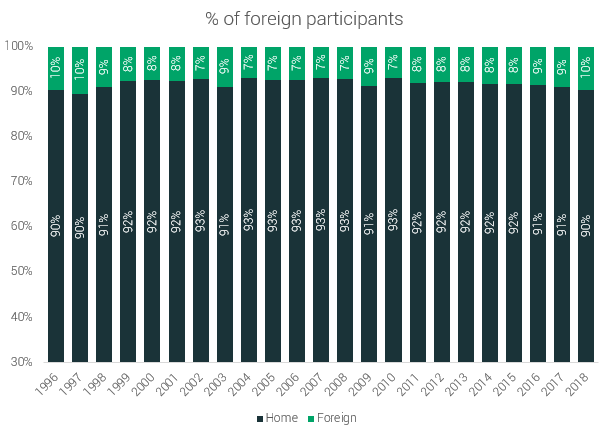
It turns out that people are traveling more for a bigger challenge. Maybe because these events are rarer, or maybe because it's a bigger accomplishment and it deserves more planning and expenses.

If we compare the % of travelers in Europe and the US we get the following result.
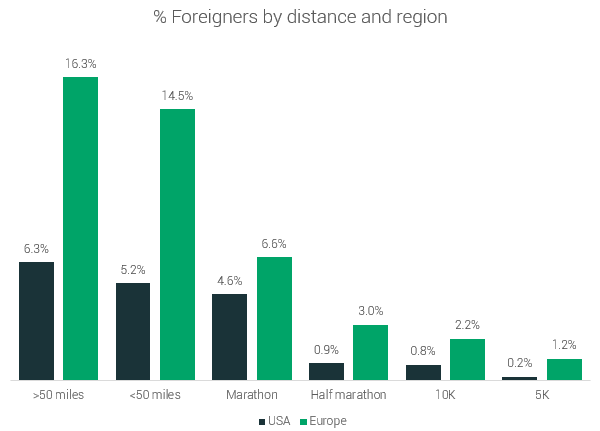
People in Europe travel a lot more to foreign counties than the people in the US. This is due to the proximity of such countries and the open borders in the EU.
Racing patterns of runners
We have also examined how the behavior of runners change through their running careers.
Most ultrarunners choose a shorter distance for their debut in ultra running. Then they challenge themselves more and more until their 15th race. After that with age and experience, they start choosing shorter distances, and we can extrapolate that they run more for pleasure than for achievement.

The pace of the ultra runners changes during their careers. In the beginning, despite the fact that they are running shorter races, their pace is quite slow. With experience, it gets better and better in their first 20 races. After that runners set in their comfortable pace, and it stays quite stable.
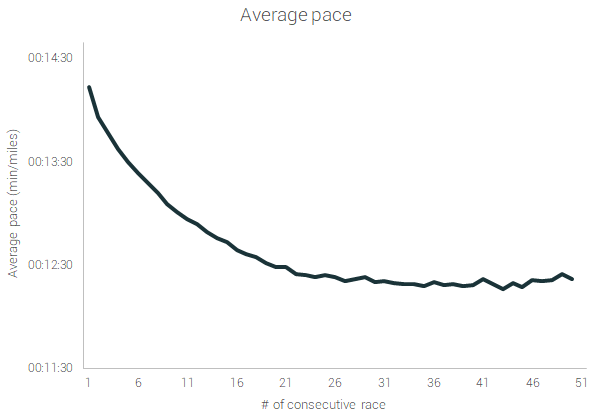
About the IAU
The International Association of Ultrarunners (IAU) is operating under the patronage of the IAAF and is dedicated to developing ultra distance running internationally within the IAAF Rules & Regulations. As an international governing body for ultra-distance running, the main objectives are to promote and develop long-distance running worldwide.
Running ultra-distance races requires the right shoes
Long-distance racing requires a lot of training and a lot of miles, requiring the best ultra-running specific footwear. Many ultras are on rocky trails and hardpacked dirt, buying the right trail running shoes or cushioned shoes can help with injury prevention and efficiency.
Some brands like Hoka, Altra, and Topo Athletic offer maximalist shoes designed to soften the impact of long-distance running, while other bands like Merrell or Vibram offer minimalist shoes for ultra runners that like to feel the trail beneath their feet.
RunRepeat covers more than just running statistics and training for ultras, we review hiking boots, hiking shoes, and hiking sandals from top brands like Danner, Salomon, Adidas, Teva, KEEN, plus many more.
Our goal is to help you easily find the right footwear so you can spend more time outside enjoying the sports you love! We do that by publishing the most objective and unbiased reviews out there: we get the shoes with our own money, we run in them, and we test them in our lab. Be sure to check out our in-depth studies on the sports we love and learn more about RunRepeat today.
Use of content
- We are happy to give interviews on the topic at any time. For this purpose or for print-use questions please reach out to Paul Ronto at paul@runrepeat.com.
- Feel free to use material from this page in any web coverage of the topic, we just ask that you refer, and link, back to this original source.
